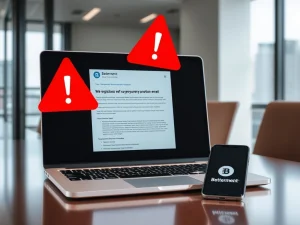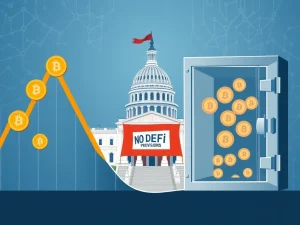Kinto Token Plunges 81%: Tragic Ethereum L2 Shutdown After Critical Crypto Hack

The cryptocurrency market recently witnessed a dramatic and concerning event. Kinto Network’s native Kinto token experienced a devastating 81% decline. This sharp drop followed an official announcement. The team confirmed its Ethereum L2 blockchain would initiate a blockchain wind down by September 30. This news sent shockwaves through the community. It marked a significant DeFi project failure. Investors and enthusiasts alike are now scrutinizing the factors behind this collapse. This article explores the sequence of events that led to Kinto’s demise, offering crucial insights into the risks inherent in the rapidly evolving decentralized finance landscape.
Kinto Token Collapse: An Ethereum L2 Faces Its End
Kinto Network, an Ethereum L2 solution, recently delivered somber news. Its token, the Kinto token, plummeted over 80%. This massive drop occurred after the team announced the network’s impending shutdown. The blockchain will officially wind down by September 30. This decision comes months after a significant $1.6 million crypto hack. The hack severely crippled the protocol. Kinto’s ambition was to combine centralized exchange efficiency with decentralized security. It also aimed to offer trading for tokenized stocks. These included giants like Apple, Microsoft, and Nvidia. Despite its innovative goals, the project ultimately succumbed to a combination of internal and external pressures. This situation highlights the volatility and inherent risks within the DeFi sector.
The $1.6 Million Crypto Hack: A Critical Blow to Kinto’s Operations
A major turning point for Kinto was a substantial crypto hack in July. Approximately 577 Ether (ETH), valued at around $1.6 million, was drained from the protocol. This attack exploited a security vulnerability within the ERC-1967 Proxy standard. This standard is a common OpenZeppelin codebase. It allows smart contracts to be upgraded without changing their address. Several other projects also suffered from this vulnerability. The hack immediately placed Kinto in a precarious financial position. It severely damaged user trust. The team managed to raise $1 million in debt. This was an attempt to restore trading on its ‘modular exchange’. However, this effort proved insufficient. The lingering effects of the crypto hack were too profound. It became an insurmountable obstacle for the struggling project.
Worsening Market Conditions and the Broader DeFi Project Failure Landscape
While the crypto hack was a direct cause, worsening market conditions sealed Kinto’s fate. The team stated that these conditions “killed further fundraising.” This forced the project into a blockchain wind down. Kinto posted its decision on Medium, explaining the difficult choice. “Every day that we go on, the funds dwindle further,” the post read. “We’ve operated without salaries since July.” The team added, “After the last financing path fell through, we have one responsible choice left: shut down cleanly.” This scenario is not unique. Many new crypto ventures face immense pressure. They must secure funding in a volatile market. Kinto’s situation reflects a broader trend of DeFi project failure when external capital dries up. This is especially true for projects with high operational costs.
High APYs: A Warning Sign of Potential DeFi Project Failure?
Some observers pointed to Kinto’s excessively high annual percentage yield (APY) offerings. These were offered on stablecoins, even when the project struggled financially. One of Kinto’s founders, Ramon Recuero, noted a 130% APY in USDC in April. This was among the highest in the DeFi space. Such high yields often come with elevated risks. They can signal unsustainable business models. Many decentralized finance platforms promising astronomical returns have experienced rocky pasts. They often face liquidity issues or security vulnerabilities. This pattern suggests that an attractive APY alone does not guarantee a project’s long-term viability. Indeed, it can sometimes foreshadow an impending DeFi project failure. Investors must exercise extreme caution when encountering such offerings. Thorough due diligence is always paramount.
Kinto’s Recovery Plan and the Blockchain Wind Down Process
In its final announcement, Kinto outlined a recovery plan. The goal is to protect users and lenders as much as possible during the blockchain wind down. All remaining assets, including $800,000 of Uniswap liquidity, will move to the Foundation Safe. These funds will be distributed to “Phoenix” lenders. These lenders “took the risk” to help Kinto relaunch. They are expected to recover 76% of their loan principal. Furthermore, Kinto and Recuero are establishing a “goodwill grant” for hack victims. Each affected address will receive $1,100. Recuero personally pledged over $130,000 of his own funds. This contribution aims to provide additional relief. The Kinto team urged users to withdraw their assets by September 30. After this deadline, users will need to claim assets via a perpetual claim contract. This contract will be created by Kinto. The team also committed to continuing efforts to recover lost assets. Any recoveries exceeding victim amounts will be shared with the community via Snapshot. This platform is typically used by decentralized autonomous organizations.
Ramon Recuero’s Track Record: A Second DeFi Project Failure
The shutdown of Kinto marks a significant milestone for its founder, Ramon Recuero. It represents his second crypto venture to cease operations. His previous project, Babylon Finance, closed in November 2022. Babylon Finance also fell victim to a $3.4 million crypto hack earlier that year. Recuero similarly stated then that his team could not “revert the negative momentum.” The hack forced Babylon to shut down just six months after its public launch. This recurring pattern raises questions. It highlights the immense challenges of building secure and sustainable DeFi protocols. It also underscores the impact of security breaches. Even experienced founders struggle with these complex issues. This history serves as a stark reminder of the volatile nature of the crypto space. It emphasizes the critical need for robust security measures. Moreover, it stresses sustainable economic models to prevent repeated DeFi project failure scenarios.
The Kinto Token’s Tumultuous Journey and Market Impact
The Kinto token launched just four months ago, in April. It quickly reached an all-time high of $14.5 million on August 14. However, this peak was short-lived. The token has since tanked 81.4% to $0.46. Its market capitalization now barely hovers above the $1 million mark, according to CoinGecko data. This rapid ascent and dramatic fall illustrate the speculative nature of many new altcoins. The short lifespan of the Kinto token is a cautionary tale. It shows how quickly market sentiment can shift. It also demonstrates how external events, like a major crypto hack, can devastate a project. This sudden collapse impacts not only investors but also the broader perception of new Ethereum L2 projects. It underscores the importance of fundamental value and long-term sustainability over hype.
Lessons for the Ethereum L2 Ecosystem and Future DeFi Ventures
Kinto’s collapse offers valuable lessons for the entire Ethereum L2 ecosystem. It also provides insights for future DeFi ventures. First, robust security is paramount. Projects must prioritize comprehensive audits and adhere to best practices. They must proactively address potential vulnerabilities. Second, sustainable tokenomics and realistic APY offerings are crucial. Unrealistic yields often lead to unsustainable models. These models can collapse under market pressure. Third, transparent communication during crises is essential. Kinto’s team, despite the negative news, communicated its challenges. They outlined a plan for asset recovery. This transparency, while painful, helps manage community expectations. Finally, the importance of experienced leadership cannot be overstated. However, even experienced founders face immense hurdles. The Kinto blockchain wind down serves as a potent reminder. The DeFi space remains high-risk. Investors must conduct thorough due diligence. They must understand the technology, the team, and the tokenomics before committing funds. The future of Ethereum L2 solutions depends on building trust and ensuring long-term viability.
Conclusion: The Aftermath of Kinto’s Blockchain Wind Down
The dramatic fall of the Kinto token and the subsequent blockchain wind down of its Ethereum L2 network represent a significant event in the crypto world. A devastating crypto hack, coupled with challenging market conditions, proved insurmountable for the project. This led to a painful DeFi project failure. The story of Kinto highlights critical lessons. It underscores the importance of security, sustainable financial models, and transparent communication. As the crypto industry continues to mature, such events serve as powerful cautionary tales. They remind us of the inherent risks. They also reinforce the need for continuous innovation, robust security, and responsible project management. The Kinto Network’s closure is a stark reminder. Building and maintaining trust in decentralized finance requires constant vigilance and unwavering commitment to user safety.






